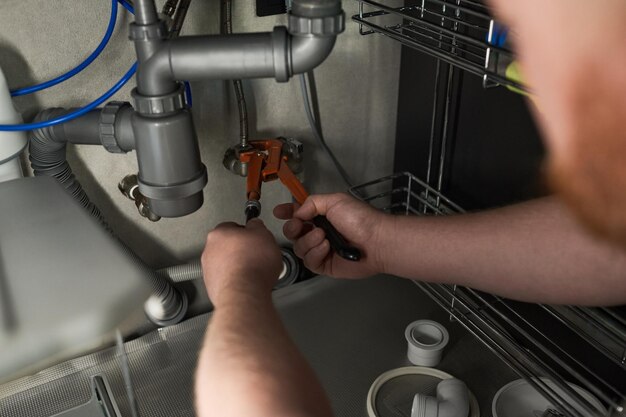Understanding the Size of Refrigerator Water Lines: A Comprehensive Guide
When it comes to setting up a refrigerator with a water dispenser and ice maker, the refrigerator water line plays a crucial role. While it might seem like a minor detail, choosing the right size can impact installation ease and appliance performance. In this guide, we'll explore the ins and outs of refrigerator water lines, their sizes, related installation details, and practical considerations for homeowners.
📏 What is a Refrigerator Water Line?
A refrigerator water line is a tubing system that connects your refrigerator to the main water supply. It delivers water to the ice maker and water dispenser, ensuring your fridge operates seamlessly. Understanding the correct size and type of this line is vital for efficient appliance use.
Main Features:
- Material: Commonly made from copper, stainless steel, or plastic (PVC or polyethylene).
- Function: Supplies water for ice production and chilled water dispense.
- Connection Points: Attaches to the refrigerator and the home’s water supply line.
🚰 Common Sizes of Refrigerator Water Lines
The diameter of refrigerator water lines can vary, but there are standard sizes most often used in household setups. Let’s explore these sizes along with their implications:
Standard Sizes
1/4-Inch Diameter: The most commonly used size for household refrigerators. This size supports adequate water flow for both ice production and water dispensing while being relatively easy to install.
3/8-Inch Diameter: Though not as common, some setups may use a 3/8-inch line, especially where longer runs are involved, as this can help maintain water pressure throughout the system.
Impact of Line Size
- Water Pressure: A larger diameter, like a 3/8-inch line, can maintain pressure over longer distances.
- Flow Rate: A 1/4-inch line is generally sufficient for most home needs, offering a balance between pressure and flow rate.
Practical Tip 🤔
For most standard residential refrigerators, a 1/4-inch line is typically recommended unless specific circumstances, like a particularly long distance to the water source, dictate otherwise.
☑️ Materials Used for Refrigerator Water Lines
The material of the water line can influence installation and durability. Here’s a look at the most common materials used:
Copper Lines
- Durability: Highly resistant to corrosion and cracking.
- Installation: May be more complex due to the need for precise bending and fittings.
Plastic Lines (PVC or Polyethylene)
- Flexibility: Easier to handle and install due to their flexibility.
- Cost: Generally more budget-friendly compared to copper.
Stainless Steel Braided Lines
- Strength: Combines the flexibility of plastic with the durability of metal.
- Appearance: Often chosen for its sleek look and strength.
Installation Tip 🛠
Consider stainless steel braided lines for more durability and a neater installation, especially if the line runs in visible areas.
🔧 Installation Essentials
Proper installation ensures your refrigerator operates effectively and safely. Here’s what you need to know about installing a refrigerator water line:
Tools Needed
- Adjustable wrench
- Utility knife or pipe cutter
- Teflon tape
- Drill (if necessary for making holes)
Step-by-Step Installation
Measure Your Line: Before cutting, make sure you’ve measured the distance between your refrigerator and the water source precisely.
Shut Off Water Supply: Always turn the water supply off before starting any plumbing work to prevent leaks.
Connect the Line: Attach the line to the refrigerator and the water supply, ensuring all fittings are secured and wrapped with Teflon tape to prevent leaks.
Check for Leaks: After installation, turn the water supply back on and check for leaks. Tighten connections if necessary.
Troubleshooting Tip 🔍
If water flow is weak, ensure there are no kinks in the line and that all connections are secure.
⚙️ Maintenance and Troubleshooting
Even with the correct setup, maintenance ensures longevity and proper functioning:
Regular Inspections
- Check for Leaks: Regularly inspect the line for any signs of moisture or leaks.
- Replace Worn Lines: Over time, plastic lines can become brittle; plan to replace them every 5-7 years.
Addressing Common Problems
- Low Water Pressure: Check for kinks or clogs in the line.
- Noise: Secure any loose connections or lines to minimize movement and noise.
Proactive Tip ⏲️
Add a reminder to check your water line annually or set an alert on your smartphone to ensure regular maintenance.
🌟 Summary of Key Points
Here are some essential takeaways when considering refrigerator water lines:
- Size Matters: The standard 1/4-inch line is suitable for most homes, but longer runs may require a 3/8-inch line.
- Material Choices: Opt between copper, plastic, or stainless steel based on budget, durability needs, and flexibility.
- Regular Maintenance: Conduct annual checks for leaks and replace lines every few years to ensure safe operation.
- Installation Tips: Use Teflon tape for connections, check for kinks, and ensure the line is securely fastened to maintain optimal flow.
By understanding the nuances of refrigerator water lines, from size to installation and maintenance, homeowners can ensure their appliances run smoothly and efficiently. Remember, proper installation not only prevents leaks and increases efficiency but also prolongs the life of your appliance's water supply components.
👩🔧 Empower Your Home Setup: Make informed decisions based on your specific household needs, and consider consulting a professional if installation seems daunting. Opt for materials and sizes that best fit your home's setup, keeping both functionality and convenience in mind.
